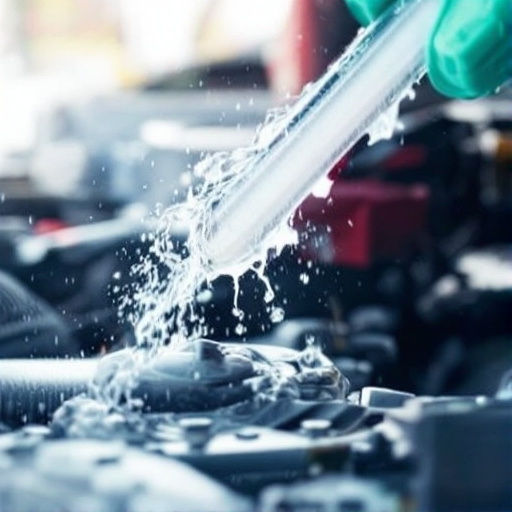Related Articles
- Charged Up! How Electric Vehicles are Reshaping Urban Wildlife Habitats and Biodiversity
- Navigating the Used Car Market: Uncovering the Secrets of 'As-Is' Sales for Savvy Buyers
- The Rise of Electric Car Pop-up Shops: A New Frontier for Urban Retail Experiences
- The Forgotten Art of DIY Car Maintenance: Rediscovering Skills in a Tech-Driven World
- Electric vs. Vintage: The Battle for Enthusiasts' Hearts in the Age of Latest Car Models
- The Rise of the 'Car Review Influencer': How Social Media is Shaping Auto Buying Decisions
"Unlocking Your Car’s Secrets: The Surprising Role of Ambient Temperature in Your Vehicle's Maintenance Routine"
"Unlocking Your Car’s Secrets: The Surprising Role of Ambient Temperature in Your Vehicle's Maintenance Routine"
Understanding how ambient temperature affects your vehicle can unveil crucial insights into its maintenance needs. From tire pressure to battery performance, this article explores the surprising interplay between temperature and car care, confirming that what you feel outside can deeply impact your ride's performance.
What’s the Deal with Temperature?
It’s more than just a number on the weather report—ambient temperature plays a critical role in the functioning and maintenance of your vehicle. Most people ignore the outside world when tuning up their cars, but your car's aerodynamics, engine performance, and fluid viscosity among myriad other factors can all be influenced by various environmental conditions.
Brake Pads and Temperature: A Love/Hate Relationship
Have you ever noticed that your brakes feel different in winter versus summer? In colder temperatures, brake pads can harden, leading to less effective braking. A study from BrakeSafety.com found that, on average, drivers experience a 16% decrease in braking efficiency when temperatures drop below freezing. On the other hand, when temperatures soar, brake pads can wear out faster due to increased friction.
Fact or Fiction: The Cold Start Engine Issue
Imagine it’s the dead of winter, and you’re running late for work. You jump in your car, crank the ignition, and potentially cause more harm than good. Contrary to popular belief, allowing your car to idle for an extended period too often in frigid temperatures isn’t best practice. According to the automotive experts at Car and Driver, modern engines don't need to warm up significantly before driving—that’s a remnant of old technology. Instead, driving gently from the get-go can warm up your engine more effectively, as long as you keep speeds low until the temp gauge rises.
Battery Blues: A Cold Snap’s Worst Nightmare
It’s no secret that car batteries don’t love cold weather. In fact, when the temperature drops to -20°F, a battery loses about 60% of its cranking power, making it challenging to get your car running. In a case study published by AAA, they found that over 25% of winter breakdowns are due to battery failure. As the winter months creep up, make it a priority to check your battery health, and perhaps invest in a battery warmer to keep things running smoothly!
Maintaining Tire Pressure: A Tread Lightly Approach
Did you know that your tires lose about 1 psi for every 10°F drop in temperature? If it’s winter, this can mean the difference between safe steering and slipping into a ditch. According to the National Highway Traffic Safety Administration (NHTSA), under-inflated tires can decrease fuel efficiency by up to 3%. Regular checks can save you a trip to the gas station.
Anecdotes from the Road: Real-Life Experiences
One particularly chilly morning, my friend Sarah experienced the classic dilemma of cold weather woes. After months of slightly ignoring her tire pressure light because “it always comes on in winter,” she found herself skidding on ice after the light turned redder than a stop sign. It turns out her tires were nearly 10 psi under the required pressure! She swore that day she’d treat her car right—giving her tires the attention they deserved.
Summer Heat: The Other Side of the Coin
During sweltering summer months, the opposite can occur: tires may overinflate. This leads to an increased risk of blowouts. A survey by TireRack revealed that almost 12% of drivers have experienced a tire blowout due to overinflation, typically when ambient temperatures rise and no checks are performed. Keep a close eye on those tire pressures—especially when you plan on hitting the highway!
Fluid Fluctuations: Keeping Your Car Healthy
Engine oil, coolant, and brake fluid all experience viscosity changes based on temperature. Viscometer tests often reveal that when temperatures dip, oils can become thicker, whereas heat can make them thinner. Therefore, knowing when to swap out fluids based on season can prolong your car’s life significantly. For instance, transitioning from conventional oil to synthetic in extremely cold conditions can enable faster cold starts and better lubrication.
How Hot is Too Hot? Cooling System Concerns
Conversely, during summer heatwaves, overheated engines can become a real threat if the cooling system isn’t in check. When temperatures rise, your engine is working overtime. A few summers back, I had an acquaintance who ignored an overheating warning and ended up with a blown head gasket. The repair bill? A whopping $3,000! Keep your cooling system topped up to avoid pricey mishaps!
Seasonal Car Care Checklist: What to Do?
So, how can you prepare your vehicle for the drama of changing seasons? Here’s a quick seasonal checklist:
- Winter: Check battery health, tire pressure, and antifreeze levels.
- Summer: Monitor cooling systems, check fluids regularly, and watch for tire overinflation.
- Year-Round: Keep a monthly schedule for oil checks, fluid levels, brakes, and tire rotations.
The Importance of Storing Your Vehicle
If you’re a classic car owner or someone with a cherished vehicle, ambient temperatures can pose an even greater challenge during storage seasons. Climate-controlled garages may seem like a luxury, but they actually preserve the lifespan of vehicles. According to ClassicCars.com, cars stored in regulated environments have a 50% lower risk of developing rust issues or mechanical problems over time.
Conclusion: The Key Takeaway
Your vehicle holds many secrets, and understanding how ambient temperature affects maintenance can lead you to a smoother ride and prolonged vehicle lifespan. From battery strength to tire performance, every element plays a role when temperatures fluctuate. So, tweak those tire pressures, pay attention to your fluids, and keep your battery happy—the wellness of your car may very well depend on it! Remember, whether it's the heat of summer or the chill of winter, your car deserves the best—because an informed driver equals a safe driver. So next time you step out, take a moment to consider the temperature’s secret role in your car care routine!
Bonus: Fun Facts About Temperature and Cars
1. Did you know that the ideal temperature for most car batteries to function optimally is between 70°F and 80°F? Outside of that range, you're risking underperformance.
2. Stress on your engine can double when temperatures rise above 90°F—an extra reason to keep a check on your cooling systems in the summer!
3. According to stats, nearly 75% of drivers do not regularly check their tire pressure. Make sure you’re not part of that statistic!




